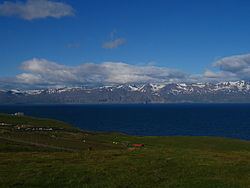 | ||
Skjálfandi, (also known as Skjálfandaflói), geologically more a bay than a fjord, is located in northern Iceland. The Icelandic word "Skjálfandi" literally translates as "trembling" which might refer to earthquakes in the area.
Map of Skj%C3%A1lfandi, Iceland
The bay, originally created by glacial activity, has two major streams flowing into it: Skjálfandafljót, which is a glacier river, and Laxá, which is a freshwater river. The river Laxá (English: "Salmon River") is famous for its salmon and part of the river is protected by the Ramsar Convention.
The only town in Skjálfandi Bay is Húsavík, facing the snow-covered Víknafjöll and Kinnarfjöll mountain ranges on the other side of the bay. The highest point reaches around 1200 metres.
The bay is known for its many different whale, dolphins and bird species.
There are two islands in Skjálfandi. The biggest is Flatey which name means flat island. It is situated close to the opposite side of the bay from Húsavík. There is a village on the island, nowadays not any more inhabited, composed of few houses, a school and a church. There is no ferry serving Flatey. Skjálfandi's minor island is called Lundey. Its name means island of the puffins because of the great colony of puffins living on its cliffs during the summer. Lundey is located close to Húsavík.
The Swede Garðar Svavarsson was one of the first Scandinavians to settle in Iceland around 860 CE. He built a house in Skjálfandi, but spent only the following winter months there before leaving Iceland.
